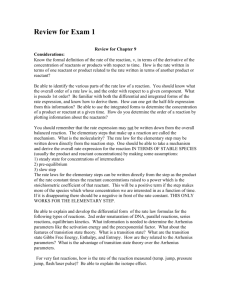Brief Guidelines
advertisement
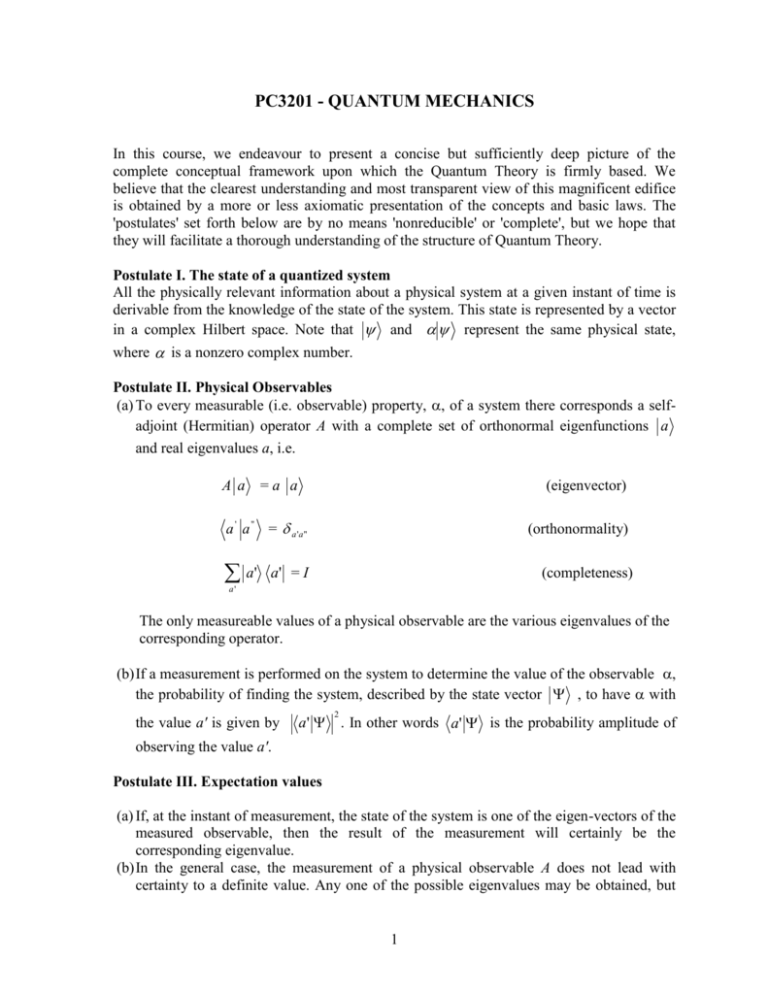
PC3201 - QUANTUM MECHANICS
In this course, we endeavour to present a concise but sufficiently deep picture of the
complete conceptual framework upon which the Quantum Theory is firmly based. We
believe that the clearest understanding and most transparent view of this magnificent edifice
is obtained by a more or less axiomatic presentation of the concepts and basic laws. The
'postulates' set forth below are by no means 'nonreducible' or 'complete', but we hope that
they will facilitate a thorough understanding of the structure of Quantum Theory.
Postulate I. The state of a quantized system
All the physically relevant information about a physical system at a given instant of time is
derivable from the knowledge of the state of the system. This state is represented by a vector
in a complex Hilbert space. Note that and represent the same physical state,
where is a nonzero complex number.
Postulate II. Physical Observables
(a) To every measurable (i.e. observable) property, , of a system there corresponds a selfadjoint (Hermitian) operator A with a complete set of orthonormal eigenfunctions a
and real eigenvalues a, i.e.
A a
=a a
(eigenvector)
a ' a " = a 'a"
a'
(orthonormality)
a' = I
(completeness)
a'
The only measureable values of a physical observable are the various eigenvalues of the
corresponding operator.
(b) If a measurement is performed on the system to determine the value of the observable ,
the probability of finding the system, described by the state vector , to have with
the value a' is given by
a'
2
. In other words a' is the probability amplitude of
observing the value a'.
Postulate III. Expectation values
(a) If, at the instant of measurement, the state of the system is one of the eigen-vectors of the
measured observable, then the result of the measurement will certainly be the
corresponding eigenvalue.
(b) In the general case, the measurement of a physical observable A does not lead with
certainty to a definite value. Any one of the possible eigenvalues may be obtained, but
1
with different probabilities. The average value (expectation value) of the result of the
measurement of A is given by the expression
A
A
=
* x Ax dx
* x x dx
(coordinate representation)
, A
,
Here denotes the state vector of the system at the moment of measurement.
Postulate IV. Complete set of compatible observables.
For any physical system, it is always possible to perform a complete set of compatible
independent measurements, i.e. measurements which do not perturb the values of the other
observables previously determined. The results of all possible compatible measurements can
be used to characterize the state of the system, as they provide the maximum possible
information about the system.
Postulate V. Construction of operators
(a) Any classical physical quantity must be considered to be constructed from pairs of
canonically conjugate variables. The corresponding quantum-mechanical operator is then
obtained by replacing the canonical variables by their corresponding quantummechanical operators.
(b) For all pairs of the basic canonically conjugate operators the following Heisenberg
commutation rules hold:
x i , p j = i ij ( i, j =1,2,3)
Here x i , p j are respectively the position and momentum operators of the system.
Postulate VI. Equation of motion
The dynamical behaviour of a non-relativistic system is described by the Schrodinger
equation
i
H
t
Here H is the Hamiltonian operator of the system.
2
Some useful relations:
(1)
*
(2) x x ,
(3)
A
*
p p
A†
A is any operator and A† its adjoint.
(4) If { ai }are the eigenstates of the observable A and any state vector, then, for ai
lying in the discrete spectrum,
=
a
ai
i
i
=
c
i
ai
where ci = ai
i
If ai lies in the continuous spectrum instead, then we have
a da a
= a a da
=
(5) (A† ) † = A
3
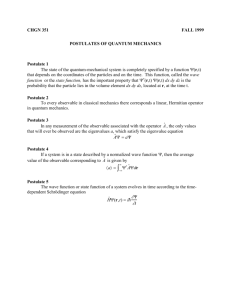

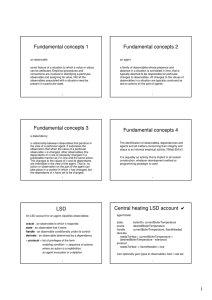



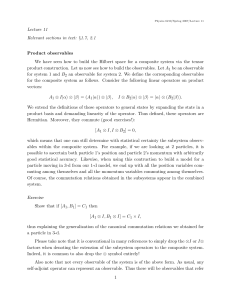

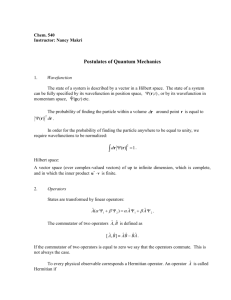
![Peirce The Doctrine of Necessity Examined [DOC]](http://s3.studylib.net/store/data/007172288_1-f48e93a14fde7ce78d2562a21bd3c547-300x300.png)
